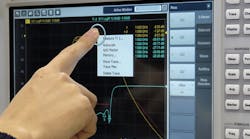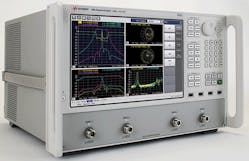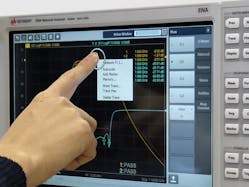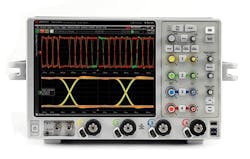In anticipation of the upcoming IEEE International Microwave Symposium (IMS) exhibition week in Phoenix, Ariz., Keysight Technologies has unveiled several new instruments that should be of interest to many show-floor visitors. Two of the instruments—the model E5080A ENA network analyzer and the Infiniium V-Series oscilloscopes—bring a great deal of high-frequency analysis power, and are aimed at “midyear budgets.” In spite of their practical pricing, these new instruments bring the highest levels of accuracy and great measurement power, and will be on display at IMS booth No. 739.
This file type includes high resolution graphics and schematics when applicable.
The E5080A ENA vector network analyzer (Fig. 1) is well suited for research and production environments. It is available with two- and four-port test sets with versions for use from 9 kHz to 4.5 GHz; 9 kHz to 6.5 GHz; and 9 kHz to 9.0 GHz. Although these instruments are not designed to replace the company’s metrology-standard line of PNA vector network analyzers (VNAs), they deliver a good percentage of the PNA performance at a fraction of the price.
The E5080A ENA analyzers have a modernized graphical user interface (GUI) for easy operation. Measurement results are shown on a bright 12.1-in. thin-film-transistor (TFT), liquid-crystal-display (LCD) touchscreen display with 1280 × 800 pixel resolution (Fig. 2). The analyzer is equipped with Type-N female front-panel connectors and a rear-panel BNC female connector for external triggering purposes. The E5080A ENA analyzers are available with a bias T for active device measurements.
In spite of the E5080A ENA analyzers having been developed as cost-effective alternatives to the PNA analyzers, they deliver outstanding performance in their own right. For example, they maintain wide dynamic measurement range across the frequency range, even though these analyzers reach down into the frequency range. The typical dynamic range performance at the test port is 132 dB at the lowest frequencies (through about 100 kHz); typically 147 dB from 50 MHz to 6 GHz; 140 dB from 6.0 to 8.5 GHz; and typically 130 dB from 8.5 to 9.0 GHz.
For such large dynamic-range numbers, the E5080A ENA analyzers still perform quickly, with measurement speed of 3 ms for testing with 201 points and a two-port calibration. Such fast measurement speed and wide dynamic range supports the testing of a number of different component types, including broadband filters.
Using the calibration kit to perform a full two-port calibration, the corrected system performance in terms of directivity is better than 46 dB through 3 GHz; better than 40 dB through 6 GHz; and better than 38 dB through 9 GHz. Similarly, with the same type of calibration, the load match is better than 46 dB through 3 GHz; better than 40 dB through 6 GHz; and better than 36 dB through 9 GHz.
The test port frequency, which can be set with 1-Hz resolution, maintains standard continuous-wave (CW) accuracy of ±7 PPM at room temperature, with optional CW accuracy of ±0.45 PPM accuracy available for demanding requirements. The output power at the test port can be set with 0.01-dB resolution. It is specified as -90 to +10 dBm from 9 kHz to 50 MHz; -90 to +15 dBm from 50 MHz to 6 GHz; -90 to +12 dBm from 6.0 to 8.5 GHz; and -90 to +8 dBm from 8.5 to 9.0 GHz.
The output-power level accuracy for a stepped sweep is ±2.0 dB from 9 to 50 kHz and ±1.5 dB from 50 kHz to 9 GHz. Test port harmonics are better than -20 dBc through 9 GHz, while spurious content is better than -30 dBc through 9 GHz.
Not to be outdone, the firm introduced the Infiniium V-Series oscilloscopes, building upon an innovative front end that helps dramatically reduce noise as part of a measurement. Different models are available with test bandwidths of 8 through 33 GHz for two measurement channels and from 8 to 16 GHz for four measurement channels. The oscilloscopes (Fig. 3) are available as the DSO models, with four analog channels; the DSA models, with four analog channels; and the MSO models, with four analog channels and 16 digital channels. Maximum sample rates are 80 GSamples/s for two channels and 40 GSamples/s for four channels. For those who start out low in frequency and want to move higher, each model is upgradeable to a higher bandwidth.
These oscilloscopes achieve remarkable 100-fs time jitter. They build on the firm’s investment in indium-phosphide (InP) integrated circuits, especially for such circuits as the trigger IC, the input preamplifier, the ADC amplifier, and the probe amplifier. Together with Quick Film 3D and the use of ceramic substrate in the packaging, the InP devices are kept cool and reliable over time, and support low-loss, high-frequency operation through 33 GHz.
Like the E5080A ENA analyzers, the Infiniium V-Series oscilloscopes show test results on a bright and flexible 12.1-in touchscreen display screen. The capacitive touch screen supports as many as 8 waveform windows with as many as 16 separate grids in each, for as many as 128 simultaneous viewing areas, which can be extended on multiple external displays.
The oscilloscopes operate with an optional 12.5-Gb/s serial trigger with 160-b sequence along with Spread Spectrum Clocking tracking in order to find and record even hard-to-track signal events. Data and waveforms can be stored on a standard removable 500-GB solid-state memory drive and transferred quickly by means of a USB 3.0 port. A total of five USB 3.0 ports are incorporated on each oscilloscope.
Keysight Technologies, Inc., 1400 Fountaingrove Pkwy., Santa Rosa, CA 95403; (707) 577-2663
This file type includes high resolution graphics and schematics when applicable.




